NASA Administrator Sean O’Keefe faced some tough questions from US senators on Wednesday as they attempted to learn how the agency would actually pay for the ambitious plan presented by President Bush a few weeks ago. Senator Bill Nelson was concerned that Bush didn’t mention the space initiative in his State of the Union announcement just six days later, “if we don’t put the full weight of the president behind it, I’m afraid it’s going to fizzle.”
An Advocate for Gusev Crater
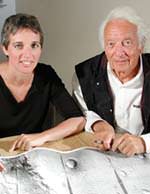
Image credit: Seth Shostak
Dr. Nathalie Cabrol spoke with me about her experiences as a scientist working with the Spirit team. This is a personal story, a snapshot taken in the midst of the swirl of events as Spirit prepares to rove the surface of Mars. She’s been at JPL since the Spirit rover landed. When asked if it’s been hard to sleep, Nathalie replied, “If this is a dream, don’t wake me up! I’ve been waiting for 15 years to see this place we’ve been dreaming about. It’s as beautiful as I expected! I’m excited and eager to step off the lander and explore Gusev Crater.”
For more than a decade, Dr. Nathalie Cabrol has been going to Mars every morning as she pursued her dreams of exploring Gusev Crater. She’s a planetary geologist with the SETI Institute and NASA Ames Research Center. In a unique scientific partnership with her husband, Dr. Edmond Grin, Cabrol studied and successfully proposed, and promoted Gusev Crater as a landing site for the martian rovers. Gusev may hold an ancient lakebed; Spirit is seeking evidence of water on Mars.
Cabrol’s dreams came true when Spirit successfully landed in Gusev Crater on January 3, 8:35 PM PST. Cabrol described the landing with excitement: “These first few days are baby steps in our giant leap toward understanding the environment of Mars. The rover landing went perfectly. We had only one tense moment after the 4th bounce when we lost contact, but we regained contact after a few minutes, and all was well. Actually, Spirit landed 32 times as it bounced across Gusev before coming to rest in the vast plain encompassed by the crater. It was a fantastic achievement! The engineers are doing the checkout now. For them, it’s business as usual, and all seems to be going well.”
After coming to a stop, the lander paused; its great balloons deflated. The rover came to life, unfolded, and phoned home. Like any good tourist, it sent a postcard home. It’s the first view of a new place, a new terrain on Mars.
Cabrol said that she felt “at home” when she saw the first views of Gusev Crater. Here on Earth, she considers herself to be a “desert rat”. She does field research in some of the most inhospitable locations on the planet such as the Atacama Desert and Lincancabur volcano in South America, extreme environments that offer Earth-analogs for Mars. Viewing Gusev through the eyes of Spirit, Nathalie sees “landscapes we know on Earth. Mars is really an Earth-like planet. But, it’s a new place on Mars. Gusev is very different from the Viking and Pathfinder landing sites. At Gusev we see lots of smaller rocks. There are fewer boulders than we saw at the other landing sites. We’re in new terrain with Spirit.”
How does she feel about where Spirit finally landed? “We landed in the sweet spot. Gusev is known to be dusty, but we landed where most of the dust has been removed in places by winds and dust devils. Some rock looks clean enough, and this will make our scientific work much easier. We’ll spend less energy cleaning and scraping the surfaces of rocks we wish to study because there appears to be little dust on them,” said Cabrol. And there are lots of rocks to study; everywhere around the lander the plain is strewn with rocks.
She’s interested in understanding the population of stones: the distribution of their shapes and sizes, the morphology and composition of the rocks, and how they were transported to their present locations. As the new, hi-resolution panoramas stream in over the next few days, she’s eagerly looking forward to seeing both the visible and infrared images as these will begin to reveal the mineralogy of the rocks.
There are other great targets for Spirit: as they retracted, the airbags scraped the surface and revealed differently colored soil that is intriguing in both its color and apparent stickiness. It’s a puzzle that requires closer inspection. There’s a nearby depression that could be an impact crater, Sleepy Hollow that offers the opportunity to get a close-up look as subsurface materials. Cabrol explained, “With the 3-D glasses, Sleepy Hollow was a blast! It just jumped out and looked a lot like as an impact crater with a solid rim armored with rock. It’s spectacular! That depression makes our lives as geologists easier. It’s like an excavated surface–so we can see what’s below.”
Why Gusev? The scientific motive for the Mars Exploration Rovers is to seek evidence of water and life, extant or extinct, on Mars. Gusev may be an ancient lakebed, and Spirit’s onboard scientific instrument package provides the virtual tools to Earth-bound geologists to look for evidence of sediments and water in the past. Where to look? There’s a team of about 50 scientists assembled at JPL. “Ideas and hypotheses are flying about the room as we actually see Gusev Crater. We are discussing and debating the best targets for Spirit as the images come back to us on Earth. It is so exciting!” said Cabrol.
Beyond the immediate terrain, there are hills and mesas. Until the stereoscopic panoramas arrive at Earth in the next few days, it is difficult to determine the distance to these features. So, it is not known whether Spirit can travel to these hills and, perhaps, come to the shore of an ancient lake. Mission success is defined as at least 90 sols (Mars days) of exploration and science, but how long can Spirit continue to rove? “As long as the rover and the scientists remain healthy, we’ll keep exploring. It’s so challenging to get to Mars, and land successfully that we have to go on as long as possible.”
Today, Cabrol is making her first virtual steps on the Martian surface. In the future, she dreams of going to Mars. When asked about the Saturday night landing, she said, “There’s only one thing that didn’t land on Mars, and that’s me!” For now, she’s there virtually and she just finds Gusev Crater “beautiful. It’s simply beautiful.”
Original Source: Astrobiology Magazine
Researchers Create a New Plasma Thruster
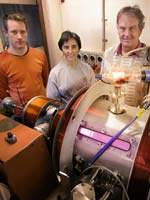
Image credit: ANU
The dream of manned missions to Mars and beyond could become a reality thanks to plasma technology developed at ANU.
Research results to be published in the journal Applied Physics Letters this week show that the ANU Helicon Double Layer Thruster (HDLT) can be powered by hydrogen ? an otherwise unusable waste product in manned spacecraft.
The HDLT uses solar electricity from the sun to create a magnetic field through which hydrogen is passed to make a beam of plasma, which powers a ship through space.
While the plasma thruster has a fraction of the power of the rockets that launch the space shuttle, it uses far less fuel and gets more thrust as a ratio of the fuel it burns, making it ideal for interplanetary missions.
“The Americans say they want to send men to Mars ? this is the technology to take them there,” said the HDLT’s inventor Dr Christine Charles.
“This thruster gives Australia a fantastic opportunity to be part of the international space race.”
The ANU team led by Professor Rod Boswell has been in close collaboration with NASA, helping US scientists fix glitches with their own plasma thruster, the Variable Specific Impulse Magnetoplasma Rocket (VASIMR) invented by veteran shuttle astronaut Franklin Chang-Diaz, who visited ANU last year.
While the technology of plasma thrusters is not new, its popularity has only taken off in recent years, with it being used to help satellites maintain their positions in orbit. However, the NASA VASIMR concept and more recently the ANU HDLT are very recent inventions which may open the door to deep space exploration.
The ANU thruster has the edge on rival technologies as it is simpler and has been proven to work with hydrogen. Importantly, it also does not emit positively charged ions that could potentially cause a disaster by interfering with a spacecraft’s communications systems.
“The HDLT is a beautiful piece of physics because it is so simple. It doesn’t need any moving parts,” Dr Charles added.
Original Source: ANU News Release
Opportunity Begins Standing Up
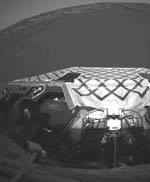
Image credit: NASA/JPL
NASA’s Opportunity rover has untucked its front wheels and latched its suspension system in place, key steps in preparing to drive off its lander and onto martian soil.
Overnight tonight, mission controllers at NASA’s Jet Propulsion Laboratory, Pasadena, Calif., plan to try tilting the lander platform down in the front by pressing the rear petal downward to raise the back.
“What we want to do is lower the front edge by about 5 degrees,” said JPL’s Dr. Rick Welch, activity lead for preparing the rover for roll-off. Plans call for driving off straight ahead, possibly as early as overnight Sunday-Monday, if all goes well.
Meanwhile, halfway around Mars, Opportunity’s twin, Spirit, continues on the mend from a computer memory problem that struck it a week ago. “Right now we’re working to get complete control of the vehicle, and we’re still not quite there,” said JPL’s Jennifer Trosper, mission manager. “If we’re on the right track, we hope to be back doing some science by early next week. If we’re not on the right track, it could take longer than that.”
Opportunity’s infrared sensing instrument, the miniature thermal emission spectrometer, passed a health check last night. Scientists plan to begin using it tonight. The instrument detects the composition of rocks and soils from a distance. That information will help scientists decide what targets to approach after Opportunity drives off the lander.
Scientists and rover engineers are already discussing which specific rocks within an outcropping near the lander will make the best targets, said Dr. Jim Bell of Cornell University, Ithaca, N.Y., lead scientist for the panoramic cameras on Opportunity and Spirit. Details of the outcrop can be seen in a new a color-picture mosaic Bell presented, the first portion of a full-circle panorama that has been taken and partially transmitted.
Other new images show how Opportunity’s airbags left detailed impressions in the fine-textured soil as the spacecraft was rolling to a stop in the small crater where it now sits. “These marks are telling us about the physical properties of the material,” Bell said.
Some scientists believe that dark colored granules covering most of the crater’s surface were pressed down into an underlying layer of powdery, lighter red material when the airbags hit. Others hold to a theory that the dark granules are agglomerations that crumble into the finer, lighter material when disturbed. After roll-off, soil near the lander will be the rover’s first target for close-up examination with a microscope and two tools for detecting the composition of the target. The soil at Opportunity’s landing site appears to have different properties than the soil at Spirit’s landing site, Bell said.
Opportunity has already validated predictions about the landing site made on the basis of images and measurements taken by spacecraft orbiting Mars, said JPL’s Dr. Matt Golombek, a member of the rover science team and co-chair of a steering committee that evaluated potential landing sites for the rovers. The predictions included that the region of Meridiani Planum where Opportunity landed would be safe for landing, would be safe for rover driving, would have very few rocks and would look unlike any place previously seen on Mars.
“This bodes well for our ability to use remote sensing data in the future for picking landing sites,” Golombek said.
Engineers have been able to confirm a diagnosis that an unplanned drawdown of battery power each night on Opportunity is due to a heater on the rover’s robotic arm. A switch designed to overrule the heater’s thermostatic control has not been working. “In the near term, it’s not providing any operational constraints,” Welch said.
JPL, a division of the California Institute of Technology in Pasadena, manages the Mars Exploration Rover project for NASA’s Office of Space Science, Washington, D.C. Images and additional information about the project are available from JPL at http://marsrovers.jpl.nasa.gov and from Cornell University at http://athena.cornell.edu.
Original Source: NASA/JPL News Release
Scientific Equipment Headed to the Station
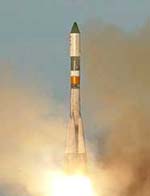
Image credit: ESA
Preparing for the arrival of the first European Automated Transfer Vehicle. Europe’s scientific utilisation of the International Space Station (ISS) took an important step forward with the launch of an unmanned Russian Progress cargo spacecraft today at 12:58 Central European Time (16:58 local time) from the Baikonur Cosmodrome in Kazakhstan.
The Progress supply vehicle will take two days to reach the International Space Station, carrying experiment hardware for the Delta mission to be carried out by ESA’s Dutch astronaut Andr? Kuipers in April, Matroshka, a European experiment facility for measuring radiation levels to which astronauts are exposed in space, and hardware to allow the European Automated Transfer Vehicle (ATV) to dock with the Station.
Launched by a Soyuz rocket on mission 13P, the Progress spacecraft with the serial number M1-11 is due to dock with the International Space Station on 31 January at 14:19 Central European Time. The Progress-type spacecraft are currently serving as supply vehicles for the International Space Station and are also uploading European hardware and equipment in advance of European missions to be carried out on the International Space Station.
Among other cargo, Progress is transporting scientific equipment which will be used during the upcoming Delta mission (Dutch Expedition for Life science, Technology and Atmospheric research). Andr? Kuipers, who on 19 April flies out to the ISS on a 10-day mission, will be employing this equipment to carry out a programme of scientific and educational activities. The Delta experiments on board Progress are:
* ARGES: This experiment will study high-intensity discharge (HID) lamps, which are used in all kinds of outdoor illuminations, making use of the absence of gravity to get new insights into how these lamps work and help develop more efficient lamps in future.
* HEAT: This experiment will be testing heat transfer properties in a section of a heat pipe with the aim of developing more efficient heat distribution systems for satellites and space vehicles in future.
* PROMISS-3: The experiment aims to analyse the growth of protein crystals in weightlessness, which cannot be observed to the same extent and with the same homogeneity on the ground.
* SUIT: The aims of this technology demonstration are to improve the orientation capabilities of astronauts and reduce space sickness. The experiment involves the astronaut wearing a special vest containing vibrating elements to assist his awareness of his position.
* ETD: This is a human physiology experiment which uses an eye-tracking device to determine eye movements in weightlessness and compare how they differ from eye movements on Earth and hence determine the effect the body?s balance system has on eye movements. This has an important bearing on balance disorders on the ground as well as in space.
* SAMPLE: This is a study into the composition and physiology of microbe species at different points around the ISS and also from the astronauts. The experiment will take samples from the chosen locations and further analyse how the different microbes found adapt to weightlessness.
* MOT: The aim of MOT is to calibrate accelerometers to be used to measure acceleration in three directions. Once calibrated the accelerometers will be incorporated into radio sensitive abdominal implants in mice for measuring acceleration, heart rate and body temperature.
Specialised containers called “biokits” are also part of the Progress cargo. They will be used to return the samples from the biological experiments taking place on the Delta mission.
Also on board Progress is a Russian spectrum analyser, not part of the Delta mission, to perform a dedicated in-orbit checkout on the European Global Transmission Services (GTS) experiment on the ISS. It will analyse the quality of the radio frequency cables of the GTS experiment, which might be the cause of the weaker than expected transmission signals received on the ground so far.
Another experiment on board Progress in addition to the Delta mission is the Matroshka experimental facility, which will be placed on the outside of the Russian Zvezda module. It will measure radiation levels experienced by astronauts in space. The facility has a human shape, consisting of a head and torso. It is made of natural bone and a synthetic material similar to human tissue. Sensors measuring radiation will be placed at various key external and internal positions on the model such as the areas of the stomach, lungs, kidney, colon and eyes. The facility will remain outside the ISS for a year. Matroshka is an ESA payload under the project leadership of DLR, the German Aerospace Centre in Cologne.
This flight is also carrying elements of the rendezvous and docking system of the Automated Transfer Vehicle (ATV), the European unmanned ISS supply spacecraft, similar in function – but not in size – to the Russian Progress. It will carry up to three times the cargo of the Progress vehicles, i.e. up to 7500kg.
The ATV-related equipment flown to the ISS consists of the following items:
* the videometer target assembly,
* laser retroreflectors,
* a container for old laser retroreflectors,
* two communication antennas,
* several cables.
This equipment from Russia and from ESA is required for the rendezvous between the first ATV, called Jules Verne, and the ISS early next year. The videometer, which will be located on the ATV spacecraft, will enable rendezvous operations in orbit to be carried out with a degree of precision never yet attained. This instrument will analyse the laser light emitted by the ATV and reflected back to it by the retroreflectors. These retroreflectors make up part of the videometer target assembly, serving as targets on the docking side of the service module. Two sets of different patterns of retroreflectors will enable the ATV ? from a distance of 300m onwards – to know its distance from and angular orientation to the ISS precisely.
The two antennas are needed for voice and data communications between the Russian Zvezda Module and the ATV. This sophisticated antenna system made in Russia will require six more, to be flown out later by other Progress ships.
All these ATV-related elements will be installed on the rear side of the Zvezda module during extravehicular activities scheduled for this July. Some old ATV retroreflectors, installed on Zvezda before its launch in 1998, will be brought back to Earth for material analysis.
The remaining experiment equipment for the Delta mission will be launched to the ISS together with Andr? Kuipers in the manned Soyuz TMA-4. This is scheduled for launch from Baikonur as mission 8S on 19 April. Kuipers is currently training for the mission at Star City near Moscow.
Original Source: ESA News Release
Opportunity Landing Site Named for Challenger Crew
NASA announced plans to name the landing site of the Mars Opportunity rover in honor of the Space Shuttle Challenger’s final crew. The area in the vast flatland called Meridiani Planum, where Opportunity landed this weekend, will be called the Challenger Memorial Station.
The seven-member crew of Space Shuttle Challenger was lost when the orbiter suffered an in-flight breakup during launch Jan. 28, 1986, 18 years ago today.
NASA selected Meridiani Planum because of extensive deposits of a mineral called crystalline hematite, which usually forms in the presence of liquid water. Scientists had hoped for a specific landing site where they could examine both the surface layer that’s rich in hematite and an underlying geological feature of light-colored layered rock. The small crater in which Opportunity alighted appears to have exposures of both, with soil that could be the hematite unit and an exposed outcropping of the lighter rock layer.
Challenger’s 10th flight was to have been a six-day mission dedicated to research and education, as well as the deployment of the TDRS-B communications satellite.
Challenger’s commander was Francis R. Scobee and the mission pilot was Michael J. Smith. Mission specialists included Judith A. Resnik, Ellison S. Onizuka and Ronald E. McNair. The mission also carried two payload specialists, Gregory B. Jarvis and Sharon Christa McAuliffe, who was the agency’s first teacher in space.
Opportunity successfully landed on Mars Jan. 25. It will spend the next three months exploring the region surrounding what is now known as Challenger Memorial Station to determine if Mars was ever watery and suitable to sustain life.
Opportunity?s twin, Spirit, is trailblazing a similar path on the other side of the planet, in a Connecticut-sized feature called Gusev Crater.
A composite image depicting the location of the Challenger Memorial Station can be found on the Web at:
http://www.jpl.nasa.gov/mer2004/rover-images/jan-28-2004/captions/image-1.html
NASA’s Jet Propulsion Laboratory (JPL), a division of the California Institute of Technology, Pasadena, manages the Mars Exploration Rover project for NASA’s Office of Space Science in Washington.
Additional information about the project is available from NASA, JPL and Cornell University, Ithaca, N.Y., on the Internet at: http://www.nasa.gov/
Ocean Patterns Dictate Dry and Wet Periods
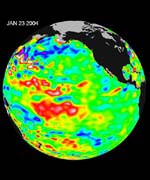
Image credit: NASA/JPL
The cooler and drier conditions in Southern California over the last few years appear to be a direct result of a long-term ocean pattern known as the Pacific Decadal Oscillation, according to research presented recently at the 2004 meeting of the American Meteorological Society.
The study by Steve LaDochy, associate professor of geography at California State University, Los Angeles; Dr. Bill Patzert, research oceanographer at NASA’s Jet Propulsion Laboratory in Pasadena, Calif.; and others, suggests Pacific oceanic and atmospheric measurements can be used to forecast seasonal West Coast temperatures and precipitation up to a year in advance, from Seattle to San Diego.
An important climate controller, the Pacific Decadal Oscillation is a basin-wide oceanic pattern similar to El Ni?o and La Ni?a but much larger. The pattern lasts many decades rather than just a few months like El Ni?o and La Ni?a. The climatic fingerprints of the pattern are most visible in the North Pacific and North America, with secondary influences coming from the tropics. The long-term nature of the pattern makes it useful for forecasting, as its effects persist for so long.
Since mid-1992, NASA has been able to provide space-based, synoptic views of the entire Pacific Ocean and its shifts in heat content through the Topex/Poseidon mission and its follow-up mission, Jason (which began in 2001). Before these satellites were available, monitoring oceanic climate signals in near-real time was virtually impossible.
The remarkable data and images can tag and monitor the shifts in short-term climate events, like El Ni?o and La Ni?a, and long-term events such as the Pacific Decadal Oscillation. These data provide a 13-year continuous, complete time-series of two major El Ni?os and two La Ni?as, and have made it possible to detect a major phase shift of the Pacific Decadal Oscillation. Patzert and LaDochy show that these data, when combined with longer-term studies of land-based data, provide a powerful set of forecasting tools.
The pattern shifted to a negative, cool phase, leading to wetter conditions in the U.S. Pacific Northwest, and drier than normal conditions in Central and Southern California this decade. Since the last El Nino in 1997-1998, the Los Angeles area has had only 79 percent of its normal rainfall, Patzert said. Lake Mead, the great fresh-water reservoir in southeast Nevada, is at less than 50 percent of normal capacity. Also, huge West Coast fires over the past few years have been greatly exacerbated by drought induced by the pattern, Patzert added.
“These shifts in the pattern are long-term tendencies, which actually have a bigger economic impact than El Ni?o,” said Patzert. “People talk about floods from El Ni?o, but what really has a harsh and costly impact is a five-year drought.”
“A full cycle of the Pacific Decadal Oscillation (cool to warm and back to cool) runs about 50 years,” said LaDochy. “Over the next several years there is going to be a tendency toward dry and colder temperatures in the southern U.S. West Coast. It is very difficult to forecast day-to-day here on the West Coast, but we can say with some confidence that over the next five years, we’d better start saving water.”
The researchers used more than 50 years of U.S. climatic information, and Pacific atmospheric and oceanic data from the National Oceanic and Atmospheric Administration?s National Centers for Environmental Prediction. By comparing data, they saw strong correlations between Pacific climate patterns, temperatures and precipitation trends on the West Coast. They then were able to develop “hindcasts” to explain temperature and precipitation variability for West Coast regions. These decadal cycles also will be useful for explaining future regional climate variability.
NASA’s Earth Science Enterprise is dedicated to understanding the Earth as an integrated system and applying Earth System Science to improve prediction of climate, weather and natural hazards using the unique vantage point of space.
For more information and images about the research on the Internet, visit:
http://www.gsfc.nasa.gov/topstory/2004/0116westcoast.html.
JPL is managed for NASA by the California Institute of Technology in Pasadena.
Original Source: NASA/JPL News Release
Martian Terrain Named for Lost Apollo Astronauts
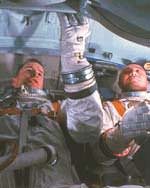
Image credit: NASA
NASA memorialized the Apollo 1 crew — Gus Grissom, Ed White and Roger Chaffee — by dedicating the hills surrounding the Mars Exploration Rover Spirit’s landing site to the astronauts. The crew of Apollo 1 perished in flash fire during a launch pad test of their Apollo spacecraft at Kennedy Space Center, Fla., 37 years ago today.
“Through recorded history explorers have had both the honor and responsibility of naming significant landmarks,” said NASA administrator Sean O’Keefe. “Gus, Ed and Roger’s contributions, as much as their sacrifice, helped make our giant leap for mankind possible. Today, as America strides towards our next giant leap, NASA and the Mars Exploration Rover team created a fitting tribute to these brave explorers and their legacy.”
Newly christened “Grissom Hill” is located 7.5 kilometers (4.7 miles) to the southwest of Spirit’s position. “White Hill” is 11.2 kilometers (7 miles) northwest of its position and “Chaffee Hill” is 14.3 kilometers (8.9 miles) south-southwest of rover’s position.
Lt. Colonel Virgil I. “Gus” Grissom was a U.S. Air Force test pilot when he was selected in 1959 as one of NASA’s Original Seven Mercury Astronauts. On July 21, 1961, Grissom became the second American and third human in space when he piloted Liberty Bell 7 on a 15 minute sub-orbital flight. On March 23, 1965 he became the first human to make the voyage to space twice when he commanded the first manned flight of the Gemini space program, Gemini 3. Selected as commander of the first manned Apollo mission, Grissom perished along with White and Chaffee in the Apollo 1 fire. He is buried at Arlington National Cemetery, Va.
Captain Edward White was a US Air Force test pilot when selected in 1962 as a member of the “Next Nine,” NASA’s second astronaut selection. On June 3, 1965, White became the first American to walk in space during the flight of Gemini 4. Selected as senior pilot for the first manned Apollo mission, White perished along with Grissom and Chaffee in the Apollo 1 fire. He is buried at his alma mater, the United States Military Academy, West Point, N.Y.
Selected in 1963 as a member of NASA’s third astronaut class, U.S. Navy Lieutenant Commander Roger Chaffee worked as a Gemini capsule communicator. He also researched flight control communications systems, instrumentation systems, and attitude and translation control systems for the Apollo Branch of the Astronaut office. On March 21, 1966, he was selected as pilot for the first 3-man Apollo flight. He is buried at Arlington National Cemetery, Va.
Images of the Grissom, White and Chaffee Hills can be found at: http://www.jpl.nasa.gov/mer2004/rover-images/jan-27-2004/captions/image-1.html
The Jet Propulsion Laboratory, Pasadena, Calif., manages the Mars Exploration Rover project for NASA’s Office of Space Science, Washington, D.C. JPL is a division of the California Institute of Technology, also in Pasadena. Additional information about the project is available from JPL at http://marsrovers.jpl.nasa.gov and from Cornell University, Ithaca, N.Y., at http://athena.cornell.edu.
Original Source: NASA/JPL News Release
Volcanoes Would Be Good Future Targets
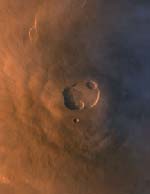
Image credit: NASA/JPL
The current generation of Mars missions have adopted the theme, “Follow the Water”, as a quest to understand the complex geological history of a planet that may have had significant reserves once. For that much warmer and wetter Mars, this motto also requires other ingredients for microbial life, including primordial “fire” in the form of biological temperature ranges.
The global picture of Mars is sometimes compared terrestrially to Antarctic dry regions, only colder. The surface temperature averages -64 F (-53 C), but varies between 200 below zero during polar nights to 80 F (27 C) at midday peaks near the equator. Such temperature extremes suggest that to realize a locally warmer Mars today may require extra heat, such as near a geothermal source.
To consider such interesting places where martian fire might work with other primordial elements like soil, wind and water to give unique science opportunities, Astrobiology Magazine had the chance to talk with Tracy Gregg, Ph.D., assistant professor of geology at the University of Buffalo and chair of the Planetary Geology Division of the Geological Society of America.
Astrobiology Magazine (AM): Given the Pathfinder and Spirit successes with airbag landings, does this descent method make scientists interested in going to places more challenging, like near volcanoes?
Dr. Tracy Gregg (TG): With the success of Spirit, I feel so much more confident about future Mars landers. The airbags seem to be able to withstand quite a bit of trauma. If both of these [Opportunity and Spirit] landers survive with airbag technology, then it blows the doors wide open for future Mars landing sites with far more interesting terrain.
A landing site near a volcano might be possible, now that the airbag technology has worked so wonderfully.
AM: Isn’t Spirit’s landing site at Gusev crater southeast about 120 miles from Apollinaris Patera, and so would that interest include taking a trip back to the Gusev region?
TG: I’d like to see us land ON a volcano. Right on the flanks.
AM: As a geologist, is there interest in the evidence for layering at Meridiani for the Opportunity mission to explore? Would that be sediment or volcanic layering?
TG: Probably some of both. There is a high possibility that we will get to see layers of ancient rock, deposited when Mars was warm and wet and could have supported life. Evidence of river channels, which we expect to see at Sinus Meridiani, could be remnants of that early, warm history. Those layers could be lava flows. Often the best place to look for evidence of life on any planet is near volcanoes.
That may sound counterintuitive, but think about Yellowstone National Park, which really is nothing but a huge volcano. Even when the weather in Wyoming is 20 below zero, all the geysers, which are fed by volcanic heat, are swarming with bacteria and all kinds of happy little things cruising around in the water. So, since we think that the necessary ingredients for life on earth were water and heat, we are looking for the same things on Mars, and while we definitely have evidence of water there, we still are looking for a source of heat.
AM: On the surface, what would exposed hematite look like in pictures? Matt Golombek, the project scientist for Pathfinder and a current rover science team member, indicated that Meridiani will look totally different from Gusev, with a grey, basaltic landscape. Are there any places on Earth that might give a tie-point to anticipating what the images will show?
TG: It depends what “pictures” you’re talking about and how fine-grained the hematite is. Hematite, if sufficiently abundant on the surface, may make the surface black and sparkly to a human eye. But it’s more likely to be observed using the special tools Spirit is equipped with–microscopic imagers and a spectrometer.
AM: Where are large hematite deposits found on Earth, and is their history terrestrially always tied to water?
TG: I’m not sure off the top of my head where they are globally–there are some huge deposits in the north-central US (think about the Minnestota and Michigan mining histories). Certainly on Earth they only form in the presence of large volumes of water.
AM: Is it correct to say that there are no active surface volcanoes on Mars today?
TG: If you’d asked me that 10 years ago–or even 5–I might’ve said yes. Now I’m not so sure.
AM: Do you think there is geological interest in landing in higher latitudes, nearer the martian poles?
TG: YES.
AM: Would the rocks be less interesting at higher latitudes but the seasons more interesting because of the presence of frost and the annual melting exchanges that happen between ice and dry-ice subliming at different rates?
TG: Higher latitudes are interesting to me because that’s where the large volcanoes are, and there’s more opportunities for magma/water interactions. Those interactions are probably extremely important for the origin and evolution of life.
AM: Are there alternatives to airbags and rocket landings?
TG: Sure, but so far airbags seem to work the best.
AM: Do you have an opinion about a sample return mission to Mars, using the Stardust mission profile–in which a projectile is dropped on the surface and that kicked-up dust is then flown through with a capture device from orbit?
TG: I’m a volcanologist who studies lava flows. I’m most interested in hard lava, or indurated volcanic ash. I’d much rather see a rock hammer go to Mars than a dust bin. However, any sample return would reveal a phenomenal amount of information about the surface processes operating on Mars.
I’d embrace any sample over none…
AM: If you were to guess at where the best chance to find active volcanology today on Mars might be, can you describe that spot briefly? For instance would this be a shield volcano visible on the surface, or some kind of subterranean magma chamber that is not exposed permanently?
TG: OK, I have to be a little picky here and supply some definitions before I can answer your question. As a planetary volcanologist, I have some pretty specific meanings in mind for certain terms, and I want to be sure you understand where I’m coming from.
Typically, a volcano on Earth is considered to be “active” if it has erupted sometime within the past 10 thousand years. By that definition, a “subterranean magma chamber” in and of itself would not constitute “active” volcanism, if all the activity is beneath the surface.
Can we use those same definitions on Mars to define “active volcanism?” Sure. But should we? I don’t think so.
The 10,000 year cutoff was chosen for Earth both for scientific and practical reasons. Scientifically, we know that it isn’t terribly likely for a given volcanic vent to spout off again if it hasn’t done anything in about 10,000 years. Practically, that’s about the time that the last Ice Age ended, leaving behind remarkable geologic signs–so all we have to do is decide if the volcanic activity is older or younger than the most recent glacial activity.
That’s not something we can do on Mars.
That said, where would I look for recent volcanic activity? Depends on how you want to define it on Mars. I strongly suspect there are still molten (or at least mushy) magma bodies beneath the huge Tharsis volcanoes, and beneath Elysium Mons.
But the youngest surficial activity discovered to date (and it’s probably 1 million years old, which would be considered quite young, and possibly “active” on Mars) is in a region that contains no large volcanic structures of any kind. Instead, there are cracks in the ground, and a few low-lying volcanoes that can’t even be seen except in the high-resolution topography (they are too subtle for imagery to reveal). This area is called Cerberus Fossae.
This tells me that “active” volcanism, if it exists in the terrestrial sense, is probably in the Northern Hemisphere, where the crust is thin, and possibly close to Tharsis or Elysium. But not necessarily.
Original Source: Astrobiology Magazine
What is that Bedrock?
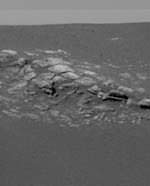
Image credit: NASA/JPL
The first impression of the Opportunity landing site in color is the light, exposed area about ten meters from the rover’s location inside a crater. The region has by now accumulated a plethora of adjectives and names: bizarre, alien, hummocky, layered, crater-rim, outcrop, stratigraphic slice, tabular, segmented, slabby.
But what has scientists most intrigued is that the slabs are bedrock. The literal foundation of Mars is its bedrock. Bedrock is the solid, intact part of the planet’s crust. Whereas in comparison to terrestrial crust, parts of southern Arizona or Louisian may have thousands of feet of unconsolidated surficial material overlying bedrock, the depth to bedrock in a place like Maine ranges from ten to only a few hundred feet. Many of the more spectacular sites in Maine feature rugged bedrock exposed to view. To find bedrock is to know geologically that the history of this location is free from rock and boulder transport, mainly by wind, water, lava and impact debris.
Whatever happened on Mars over billions of years, that hummocky slab bears its records.
Steve Squyres, principal investigator for rover science, described the five exploration stages likely to follow in the next few weeks.
While still perched on its base petal, the rover cameras will first snap panoramic color images in octets of 45 degrees each, until a full picture shows the surroundings. Without driving, the rover’s pancam can probably get a good idea of the soil and rock surface composition, using its infrared capabilities to image circular aspects of the horizon in heat-sensitive colors. Called the mini-TES instrument, the main tool for this measures thermal emissions.
The mobile laboratory will then drive off its station, maneuvering down a ramp and 40 cm drop (slightly more than a foot). The rover will look at the fine soil nearby, in hopes of finding out why this particular region is rare on Mars in being rich with iron-oxides. The surface soil’s top layer is grey, much more grey than anything seen on Mars before. On the surface, Meridiani is the darkest color yet visited.
But this dark layer gave way when the airbags were retracted revealing a deep maroon layer underneath. When summarizing the science activities by discipline, Steve Squyres noted that most of the group members–atmospherics, long-term planning, mineralogy, geology–are not fully engaged until the instrument suite is checked out and deployed on the surface. But “the soil physical properties group is having the most fun” speculating about how this maroon and grey landform came to be. Squyres described the competing theories as either “we have soil with two distinct components of coarse, grey grains on top of fine red soil–or we have aggregates that are grey but when squished, the red comes out.
When certified to drive, the rover will explore the bedrock outcrop, while looking carefully for any layers or stratigraphic history. Since the rover is inside a crater (20 meters wide, 2-3 meters deep), the next step is probably to climb out. Depending on the soil texture, the rover is probably able to climb an embankment at a relatively steep 15 to 20 degree angle. As Squyres remarked: “We traveled 200 milllon miles or so to land in a crater. It was a hole-in-one.”
Since orbital images of the landing area shows three distinct color gradations, a first guess is that once outside this crater, the view will suddenly change to what is expected to be lighter colored soil. The brightest areas seen orbitally are the crater rims, followed by the flat plains, then the darkest interior to the craters, where Opportunity now is snapping charcoal-grey scenery. Since the horizon’s range is mainly restricted to 10 meters for now, once outside this crater the startling picture of a dark grey Mars will likely change yet again.
This second soil unit is brighter, perhaps from wind not apparent inside the craters, and will be looked at closely using the same diagnostics used on the crater floor and outcrop.
Squyres said the science team then looks to “head for the big one”–a 150 meter wide crater, probably 10-15 meters deep at least and about half-a-mile away. The bright rim of that crater may well be another remnant of bedrock or something different altogether.
How that driving spree will go looks promising so far. As pancam science lead, Jim Bell, described, where they can barely glimpse the horizon, it is flat and free of large rocks for five to six kilometers. This kind of “flat-out” driving terrain makes for fewer maneuvers to go the distance.
Once they survey the real Meridiani plain outside their crater, they will gain some higher ground–about the height of an average person of five to six feet climbing out of a hole of similar depth.
As JPL Center Director, Charles Elachi, pointed out on the night when Spirit first landed, the unique part of these missions is their multiplicity–not only two views of opposite sides of the planet, but also local mobility in which each science day that involves driving is comparable to a new landing. In 1976 Viking could only reach out and scratch the soil surface. The tiny Pathfinder rover could move between larger boulders, but had limited range. The Mars Exploration Rovers, with their mobile geology toolkit, are designed for the road.
Original Source: Astrobiology Magazine
